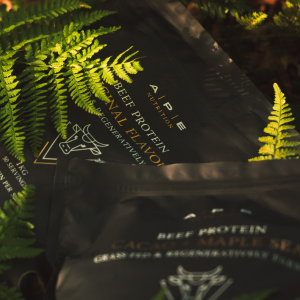For decades major organisations like the American Heart Association have been lying to us about fat. They’ve painted a black and white picture; saturated fat is bad and should be kept to a minimum, whereas monounsaturated and polyunsaturated fats are healthy. However, when in comes to fat, as is often the case with health, nutrition and life, there's nuance... the reality is there are different types of each fat, some of which are good and some of which are bad. Let’s break it down and set the record straight.
The disinformation that saturated fat is categorically bad was (and still is) disseminated as the result of a biased study and a bribe, which we've covered in detail on our Instagram. So if you want to get some context around why major 'health' institutions are literally telling you to do the opposite of what the research says is healthy when it comes to fat consumption, you can read about it by following the links below:
Why Good Fat is Great
Ultimately fat is an essential macronutrient, meaning we need it to survive. It plays a vital role in; the absorption of vitamins A, D, E and K (fat-soluble vitamins), brain health, cholesterol transportation, hormone creation, cell repair, gut health, regulating body temperature, immune function, skin / hair health, organ insulation and the list goes on.
Why Bad Fat is Deadly
Bad fat, specifically artificially created trans fats and hydrogenated vegetable / seed oils provide no benefit to the human body whilst causing serious damage. They increase bad cholesterol (oxidised LDL), reduce good cholesterol (HDL), promote inflammation and damage blood vessels. Consistently increasing inflammation within the body, as is done when these types of fats are consumed often, has been linked to the rise in basically all of the chronic diseases that are proliferating today.
Different Types of Fat
Depending on their chemical structure, fats have been grouped into four main categories:
Saturated
Benefits: Cell membrane maintenance and the primary storage form of energy. Pre-curser for Ketone creation, which can be used as fuel for the brain. Has antibacterial, antioxidant and antiviral properties, as well as aiding in gut health and cell repair.
How to recognise: Most saturated fats are solid at room temperature.
Tip: These are great for cooking because they’re not prone to oxidative damage from high heats.
Good Sources
- Grass-fed butter
- Grass-fed tallow
- Grass-fed ghee
- Coconut oil
- Coconut milk
- MCT oil
- Grass-fed meat
- Grass-fed dairy
Bad Sources
- Processed meat
- Processed cheese
Monounsaturated Fat
Benefits: Reduces inflammation, lowers blood pressure, reduces oxidised LDL (bad cholesterol) and increases HDL (good cholesterol).
How to recognise: Usually liquid at room temperature.
Tip: These aren’t great for cooking and should be kept in a dark, sealed container as they can easily oxidise when exposed to light, heat or oxygen.
Good Sources
- Organic olives / olive oil
- Organic avocado / avocado oil
- Grass-fed meat
- Organic nuts, e.g. macadamias, almonds, cashews
Bad Sources
- None
Polyunsaturated Fat
There are two major types of polyunsaturated fat; omega 3 and omega 6.
Benefits: Regulate gene expression, help in cell function and aid in the formation of cell membranes.
How to recognise: Always liquid at room temperature.
Tip: Definitely don’t cook with these as they are very susceptible to oxidative damage during cooking.
Good
- Wild-caught fatty fish such as salmon, mackerel, sardines or mussels (omega 3)
- Organic flax seeds and walnuts (omega 3)
- Grass-fed meat and animal products such as raw dairy and eggs (omega 3 & 6)
- Organic nuts (omega 6)
Bad
- Industrial processed & refined vegetable and seed oils such as canola (aka rapeseed), corn, soy, sunflower (omega 6)
Trans Fat
Benefits: Naturally occurring trans fats like CLA have been associated with improving insulin sensitivity, lowering the risk of heart disease and managing type 2 diabetes.
How to recognise: Natural trans fats are present in animal products such as meat and dairy, whereas unnatural trans fats are present in fried foods and the majority of supermarket snacks such as biscuits and chocolate.
Tip: Be practical. Try to avoid these as much as possible but unfortunately never eating a trans fat isn’t really practical in modern society. If you do eat something with trans fat in it, don’t let it stress you out. At APE Nutrition we promote the 80/20 rule where you eat really well 80% of the time and allow yourself to relax a little 20% of the time.
Good
- Grass-fed meat
- Grass-fed / raw dairy
Bad
- Fried foods
- Biscuits
- Cakes
- Crisps
- Pastries
- Chocolate
Conclusion
A key commonality amongst bad fats is the level of processing and their omega 3:6 ratio. All the bad fats listed above have undergone a huge amount of refinement, making them devoid of nutrients and potentially oxidised. They are also much higher in omega 6 and lower in omega 3. It’s thought that ancestrally we would have been eating omega 3 to omega 6 in a 1 to 1 ratio. However, modern estimates suggest that the average person is eating 10 - 20 times more omega 6 than omega 3 due largely to the huge consumption of processed and refined foods. This has been associated with an increase in inflammatory diseases, such as; heart disease, type 2 diabetes, obesity, cancer, autoimmune disease and the list goes on.
In summary, if you’re eating whole unprocessed foods and you're not overeating (which is pretty hard to do on a whole food diet), you don’t need to worry about fat. Avoid processed meat / dairy, refined vegetable / seed oils and all the supermarket stuff like crips and chocolate that contain trans fats and you’re golden!






